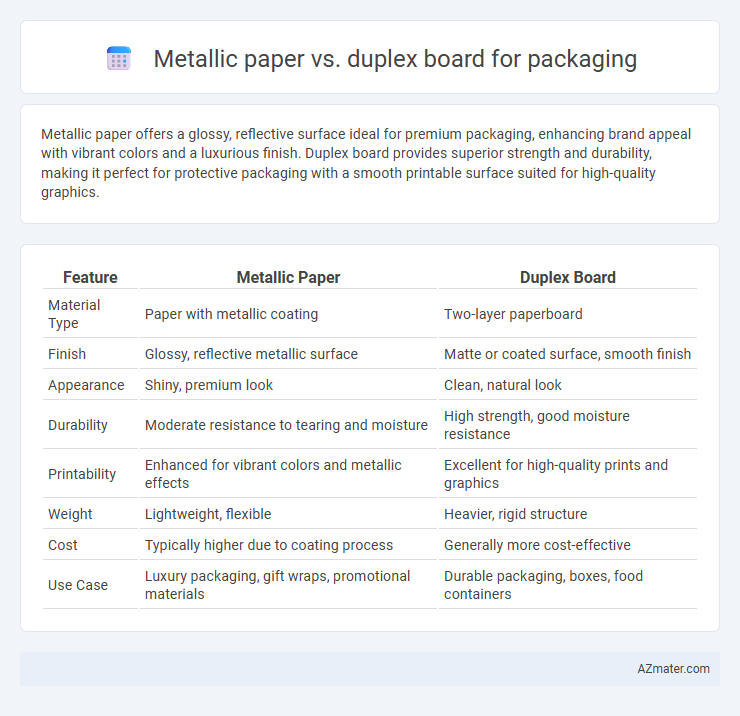Metallic paper offers a glossy, reflective surface ideal for premium packaging, enhancing brand appeal with vibrant colors and a luxurious finish. Duplex board provides superior strength and durability, making it perfect for protective packaging with a smooth printable surface suited for high-quality graphics.
Table of Comparison
| Feature | Metallic Paper | Duplex Board |
|---|---|---|
| Material Type | Paper with metallic coating | Two-layer paperboard |
| Finish | Glossy, reflective metallic surface | Matte or coated surface, smooth finish |
| Appearance | Shiny, premium look | Clean, natural look |
| Durability | Moderate resistance to tearing and moisture | High strength, good moisture resistance |
| Printability | Enhanced for vibrant colors and metallic effects | Excellent for high-quality prints and graphics |
| Weight | Lightweight, flexible | Heavier, rigid structure |
| Cost | Typically higher due to coating process | Generally more cost-effective |
| Use Case | Luxury packaging, gift wraps, promotional materials | Durable packaging, boxes, food containers |
Introduction to Metallic Paper and Duplex Board
Metallic paper features a reflective, shiny surface created by bonding aluminum particles to paper, enhancing visual appeal and luxury in packaging applications. Duplex board consists of two layers of paper pulp, typically with a white top layer for printability and a sturdy inner layer, offering strength and rigidity for packaging structures. Both materials cater to different packaging needs, with metallic paper emphasizing aesthetic value and duplex board providing durability and versatility.
Key Differences Between Metallic Paper and Duplex Board
Metallic paper features a glossy, reflective surface achieved through metallic pigments or foil, offering premium aesthetics and enhanced visual appeal for luxury packaging. Duplex board consists of two layers of paper pulp, providing superior rigidity, durability, and cost-effectiveness for structural packaging applications. While metallic paper excels in decorative impact, duplex board is favored for strength and printability in everyday packaging solutions.
Material Composition and Structure Comparison
Metallic paper typically consists of a paper base coated with a thin layer of metal, often aluminum, creating a reflective surface that enhances visual appeal and provides moderate moisture resistance. Duplex board is made from two layers of paperboard with a high-quality white top layer and a recycled or lower-quality bottom layer, offering superior stiffness, durability, and printability for packaging applications. The structural composition of metallic paper favors aesthetics and lightweight protection, whereas duplex board emphasizes strength and structural integrity suitable for heavier or more protective packaging needs.
Visual Appeal and Branding Potential
Metallic paper offers a high-gloss, reflective surface that enhances brand visibility and luxury appeal, making it ideal for premium packaging designs. Duplex board provides a smooth, matte finish with excellent printability, supporting vibrant brand colors and detailed graphics for a sophisticated look. Both materials serve distinct branding purposes, with metallic paper emphasizing elegance and attention-grabbing aesthetics, while duplex board ensures durability and versatility in packaging.
Durability and Protection Capabilities
Metallic paper offers a high-gloss, reflective surface that enhances aesthetic appeal but typically provides less rigidity and protection compared to duplex board. Duplex board, composed of sturdy fiber layers and a bleached white top layer, excels in durability and impact resistance, making it ideal for protecting heavy or fragile products. The superior structural strength and moisture resistance of duplex board ensure enhanced protection during transportation and storage.
Printing Compatibility and Customization
Metallic paper offers superior printing compatibility with high-gloss finishes and vibrant color reproduction, making it ideal for premium packaging that requires striking visuals. Duplex board provides excellent customization options through easy die-cutting, embossing, and coating, suitable for sturdy and eco-friendly packaging solutions. Both materials support advanced printing techniques such as flexography, lithography, and digital printing but vary in texture and rigidity to match specific design requirements.
Environmental Impact and Recyclability
Metallic paper often contains plastic coatings and metallized layers that hinder its recyclability and increase environmental waste. Duplex board, made primarily from recycled paper fibers and uncoated surfaces, is more eco-friendly due to easier recycling and lower carbon footprint. Choosing duplex board for packaging significantly reduces landfill contributions and supports sustainable material cycles.
Cost Analysis for Packaging Solutions
Metallic paper generally incurs higher material and printing costs than duplex board due to its specialized coating and reflective properties, which enhance visual appeal but increase expenditure. Duplex board offers a cost-effective alternative with a sturdy, recyclable structure ideal for bulk packaging, often resulting in lower overall packaging expenses. Evaluating the volume, branding requirements, and distribution logistics is crucial to determine the most economically viable choice between metallic paper and duplex board packaging solutions.
Best Use Cases in the Packaging Industry
Metallic paper excels in luxury packaging applications due to its high-shine, reflective surface that enhances brand perception and visual appeal for products like cosmetics, electronics, and premium beverages. Duplex board, known for its sturdy structure and cost-effectiveness, is ideal for sustainable packaging solutions, including food containers, pharmaceuticals, and everyday consumer goods that require eco-friendly materials with reliable strength. Choosing between metallic paper and duplex board depends on the desired balance of aesthetic impact and structural durability tailored to specific industry needs.
Choosing the Right Material for Your Packaging Needs
Metallic paper offers a luxurious, reflective finish ideal for premium packaging, enhancing brand appeal and product visibility, while duplex board provides strength, rigidity, and excellent printability suitable for sustainable and protective packaging. Selecting between metallic paper and duplex board depends on your product's protection requirements, budget constraints, and desired aesthetic impact. For high-end cosmetics or gift boxes, metallic paper excels, whereas duplex board is preferred for food packaging and heavy-duty applications requiring durability and recyclability.

Infographic: Metallic paper vs Duplex board for Packaging
 azmater.com
azmater.com